Chicken Curry in the Pakistani Manner (Murghi ka Saalan)
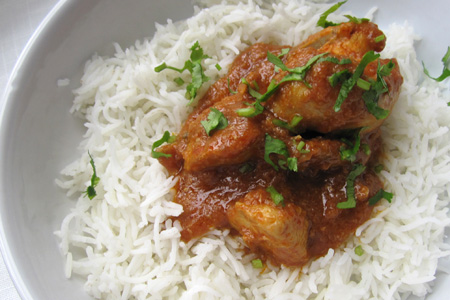

Currying Favour with the Portuguese
The great Mughal Emperor Shah Jahan, King of the World (1592-1666), died in confinement, in Agra Fort, imprisoned by his son, Aurangzeb.
As he lay dying, he looked down from the balcony of the Musamman Burj tower at the pearlescent dome of the Taj Mahal he created for his beloved wife.
Shah Jahan’s reign marked an age of opulence; as a great patron of the arts and architecture, he commissioned the creation of intricate architectural wonders in present day Pakistan, such as the Wazir Khan Mosque, Lahore, built in seven years with its architecture influenced by the popular Thatta mosaic work of the 16th century…
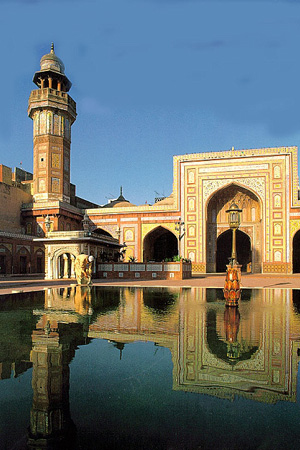
…and the Shalimar Gardens, Abode of Bliss, eight years in the making, also in Lahore. Built in 1642, the garden boasted 410 fountains, emptying out into wide marble pools.
Centered among the fountains, was an area created for musicians- a mahtabi; the moonlit gazebo. Into the night the tabla, sitar, sarod and sarangi would play.
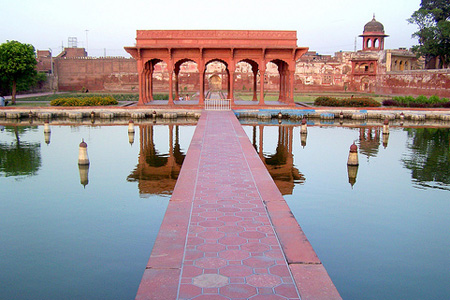
Like the architectural splendors of this era, Shah Jahan’s Imperial Kitchens were known for their excesses, similar to those of his predecessors.
Hundreds of dishes were prepared every day; decadent meat pilafs fragranced with jade-green pistachios, golden sultanas, saffron, cinnamon, nutmeg and cardamom were served to portray the glory of the Mughal Empire.
Innovation and discovery of new dishes was encouraged, with chefs brought in from Persia, Central Asia, and the Ottoman Empire to create dishes encompassing all the different regions.
Who says fusion cuisine is a 20th century phenomenon?
Pastries and cakes were prepared in the “European style“ by cooks previously enslaved by the Portuguese in Goa.
A little over a century after the arrival of Vasco da Gama on the shores of Calicut in May of 1498, the chili pepper- introduced to Goa by the Portugese– found its way into the Imperial Kitchens.*
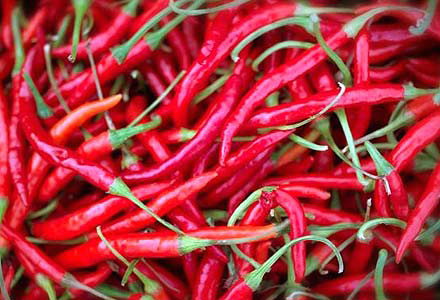
I cannot imagine my world without the chili-pepper, thank you, Vasco da Gama.
A homemade curry without the fiery quality of the chili pepper is to me, insipid at best.
That brick red chili pepper powder, as if by some form of alchemy, binds itself to the tomatoes, onions, garlic and ginger, creating a luscious, unctuous curry.
Whether you are from West Bengal, eating the curry and rice smothered with your fingertips, or from the Punjab, dipping into it with your light-as-air-chapati, or an Afghan-Pakistani like myself, dousing a steaming mound of Basmati rice with the curry, or from ‘Brum’ (Birmingham, UK) having it with pillowy naan and ‘a pint’ with your mates… you’re tucking into that unapologetically spicy curry because curry speaks one universal language for chili-heads.
This is the way I was taught to prepare it by Ami, my mother, who learnt it from Nani Ami, her mother.
No fancy ingredients or masalas (spices) here, just some good techniques which were taught to me and a few good ingredients.
The cardamom pods at the end add a subtle, lovely fragrance.
Ami and I have made life easier for ourselves by using a blender, but you’re welcome to use a pestle and mortar a la grandmum.
I like to serve it with a kachumbar, a chopped salad of cucumber, tomatoes, onions, (feel free to omit the onions) and squirts of lime / lemon with some salt.
The kachumbar adds another textural dimension with the acidity of the lime juice cutting nicely into the fat content of the curry.
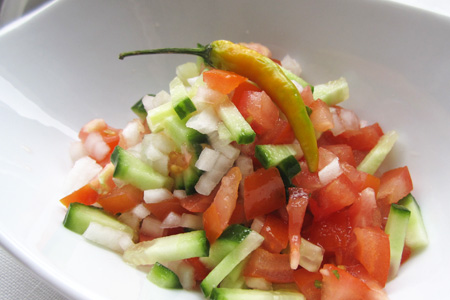
I have tried to make this with less oil, but I feel you have to go the whole hog with a curry- use the 3 tbsps of oil and if not, have an omelet or salad for dinner instead.
And make the curry the next day when you’ve done that 5k run.
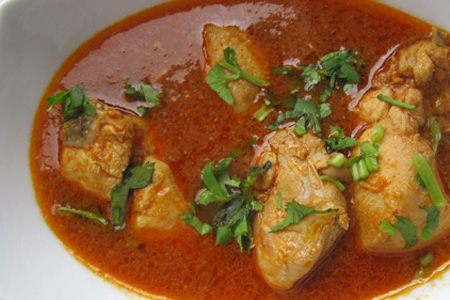
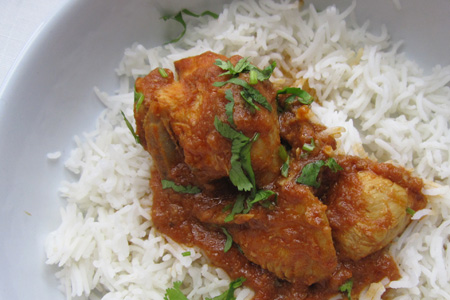
*The exact date the chili made its way to the Northern plains of India is controversial. Some believe it was two centuries after Vasco da Gama landed in Calicut; and some say the chili pepper made its way up from Goa to the North during Shah Jahan’s reign.
Photo credit Wazir Khan Mosque: TMDTUBE
Photo Credit Shalimar Gardens: Flickr
Photo Credit Chilies: Wikipedia
Chicken Curry in the Pakistani Manner (Murghi ka Saalan)
Ingredients
- 3 tbsp canola oil (or any other neutral oil like grapeseed or sunflower)
- 2 lb chicken, (I use chicken breast with bone and ask my butcher to cut it into 3in pieces or you can use a whole chicken, jointed )
- 1 medium-sized onion, roughly chopped (this will be blitzed in the blender later, so don't worry about cutting it perfectly)
- 2 garlic cloves, sliced thin (can substitute with 1 tsp garlic paste)1
- 1 thumb-size knob of ginger, sliced thin (can substitute with 1 tsp ginger paste, if ginger not available, can omit)
- 28 oz can chopped tomatoes or tomato sauce or 4-6 large fresh tomatoes, chopped
- 1 1/2 tsp salt (adjust to taste)
- pinch haldi (turmeric powder)
- 1 1/2 tsp red chili powder (I would start with 1/2 tsp)2
- 1/2 + 1 1/2 cups water
- 2 cardamom pods
Instructions
- Turn the heat to medium and place a heavy-bottomed pan, (I use a 6 qt stockpot) on the stove. To really bring out the nutty golden colour of the onions, it is preferable to not use a non-stick pan.
- Add oil and allow pan to heat up for 2 minutes.
- Add onions and saute till they start to turn golden.
- At this point, add the fresh garlic and ginger and continue to sauté.
- The onions will start to darken more, don't worry, this is what will give the curry its dark, intense colouring. The garlic and ginger will also begin to caramelise at this point.
- This will take a total of 15 minutes.
- Add tomatoes, salt, chili pepper and turmeric and turn the heat to medium or medium-high, start to "fry" (bhuno) this mixture. Be careful, the tomato sauce may splatter, in that case, turn the heat down. It will take approximately 15-20 minutes.
- By the end of it, you should see the sauce has reduced and looks jammy.
- Let the mixture cool a bit and transfer the chunky ingredients with a slotted spoon, to a blender.
- Blitz it all to a smooth paste, add some water to the blender if you want to get all the sauce off the walls of the blender.
- Transfer mixture back to the pan.
- Add chicken pieces and 1/2 cup of water and turn the heat to medium-high.
- "Fry" (bhuno) the chicken till you start to see the oil separating from the sauce. This is an indication that it is almost done. This will take approximately 15-20 minutes and rigorous stirring.
- Add the remainder of the water- 1 1/2 cups and cardamom pods, turn the heat to low, cover with a lid and let it simmer for 20 minutes. The oil should have floated freely to the top of the curry by the end of it.
- Serve with a garnish of fresh chopped coriander/cilantro, (both leaves and sweet stems), kachumbar and chapati or Basmati rice
- Note: If using garlic and ginger paste, add the paste once the onions have fully darkened, otherwise the paste will burn.

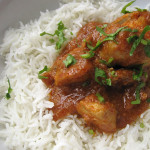






Thank you for sharing your recipe. I, unfortunately didn’t have any fresh or canned tomatoes, so ended up using tomato sauce and found it too ‘tomatoey’. Next time I’ll try using real or canned tomatoes.
I copied your recipe exactly step by step and it turned out perfect. Thank you 🙂
What can i use instead of tomato because i can’t eat cook tomato
u can add yogurt in replacement of tomato
I cooked the curry recipe today. Its simply awesome!! Will try more recepies…. Thanks a lot.
Loved it! Thank you so much for posting, I really enjoyed reading the intro too, fascinating!
Love this recipe I found it so easy to make. Please include some more recipes I really enjoyed reading them too.
Thank you for sharing your recipe. I, unfortunately didn’t have any fresh or canned tomatoes, so ended up using tomato sauce and found it too ‘tomatoey’. Next time I’ll try using real or canned tomatoes.
Interestingly, there are some parallels here with how my mum makes her Croatian stew! She does the browning of the onion, though not as dark, and she does the bhunoing! Many thanks…
I’ve been looking for a saalan recipe because it’s one of those things that I could never get just right and I have to say your recipe was amazing! My kids loved it (a big win) and I will be adding this to my regular meals – I also plan to use the saalan as a base for channa (chick pea) salan. So thank you so much for sharing and I look forward to trying out other stuff from your blog!
Food always turns out delightful by following your receipe!
Classic, tastes even better made with ghee and frying a fresh green chilli and a few of the dhania stems with the tomatoes.